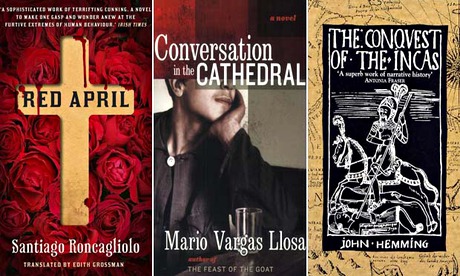
Conversation in the Cathedral by Mario Vargas Llosa
Vargas Llosa's ambitious novel is a portrait of power and politics in Peru under the dictatorship of General Manuel Odría in the 1950s.
Santiago Zavala, a young journalist, bumps into Ambrosio Pardo, his wealthy father's former chauffeur, and they go to a rundown bar in Lima (the cathedral of the title) to talk about old times. Santiago is estranged from his family, rejecting their upper middle-class values and his father Don Fermin's shady business dealings and rightwing politics. Ambrosio admires Don Fermin and served him well.
Through their reminiscences they tell the story of the country during those dark years. "At what precise moment had Peru fucked itself up?" asks Santiago on the opening page.
Vargas Llosa builds the novel around their hours-long conversation, linking it with other characters and conversations. Early on, the interlacing of dialogues between different narrators speaking at different times can be tricky, but persistence pays off.
The novel is a powerful exploration of repression, corruption and hypocrisy, along with the ugly prejudices of race and class.
Vargas Llosa, one of Latin America's best-known authors, ran for Peru's presidency in 1990. He lost, and was able to concentrate on writing rather than running the country. Twenty years later, aged 74, he won the Nobel prize.
Red April by Santiago Roncagliolo
Roncagliolo's chilling political thriller is set in the provincial town of Ayacucho in 2000, in the month leading up to Holy Week. An eccentric, mother-obsessed prosecutor, newly returned to his hometown from the capital, Lima, is asked to investigate a series of grisly murders.
He suspects the killings result from a resurgence of the Maoist-inspired Shining Path guerrillas, but the savage, two-decade insurgency that claimed 70,000 lives is officially over. "In this country, there is no terrorism, by orders from the top," a senior military officer tells him.
The lines between good and evil blur as civilians are caught between Shining Path terror and the brutal military response. Amid the violence, the state is making preparations to rig the impending presidential election. The prosecutor finds himself out of his depth as the murders get ever closer to him: "All the people I talk to die."
The suspense rises as the story takes some dramatic turns on its way to a gripping climax.
Roncagliolo excavates the dark side of his country's political and cultural turbulence, nailing entrenched corruption, impunity and racism in Peruvian society. That said, the story is served up with irony and black humour.
Peruvian writer, journalist and scriptwriter Roncagliolo now lives in Spain.
The Conquest of the Incas by John Hemming
Hemming's account of how a small band of greedy, god-fearing adventurers destroy a civilisation is a superb work of history. His impressive scholarship and sparkling prose tell an extraordinary tale of courage and cruelty, vividly describing the intrigue, treachery and slaughter that take place as Pizarro's conquistadors go about their brutish business.
The Spaniards, a mere 168 men, arrive at a time of civil wars and unrest among the native peoples, who are also decimated by the European disease of smallpox – leaving the once-mighty empire weakened. On top of that, Spanish horses, weapons and armour give the invaders superiority over the Inca forces.
The book focuses on the 40 years between the initial invasion in 1532 and the execution of the last emperor, Túpac Amaru. Although Hemming remains scrupulously impartial, it's hard not to feel sympathy for the Incas in the unequal struggle between the old and new worlds.
The Spaniards' subjugation and exploitation of the Indians shapes the hierarchical Peru of today, which still grapples with their legacy. Despite that, as Hemming points out, the Quechua-speaking population has "survived with its language and many of its customs unchanged", and forms a majority in the country.
Hemming, a British writer and explorer, is a former director of the Royal Geographic Society.

